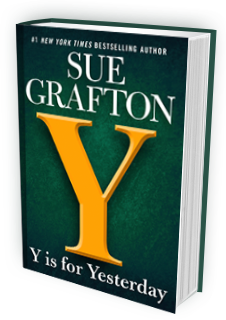Interview
A Conversation with Sue Grafton
2011
1. Early on in your new novel, Kinsey says, “I know there are people who believe you should forgive and forget. For the record, I’d like to say I’m a big fan of forgiveness as long as I’m given the opportunity to get even first.” Why did you choose vengeance as the keystone of this novel?
Personally, I’m a big fan of vengeance and I’m convinced forgiveness is vastly overrated. I’ve heard people say that in holding a grudge, you’re only hurting yourself, but it’s never bothered me a bit. I mean, what could be more satisfying than watching your enemies go down? It’s so biblical.
2. You’ve said that who hires Kinsey, and what she is hired to do, are always critically important for you as you start a new book. What’s the answer to those questions in this case?
Essentially, Kinsey is hired to do a background check on a dead woman, Audrey Vance, after her arrest for shoplifting and her subsequent fatal plunge from a bridge. The woman’s fiancé is convinced Audrey’s death was not the suicide it appears to be. Kinsey and her employer are at odds in their assessment of the woman’s criminal culpability. He sees Audrey as an unfortunate victim of circumstances. Kinsey believes she was a career thief, caught up in a professional shoplifting ring.
3. Who knew that shoplifting was such a major criminal enterprise, or that it could lead to murder? What is the scale of organized shoplifting in the United States?
The figures I’ve read are based on the FBI’s Crime Index of 2000. Their projection is that with two million shoplifter apprehensions a year, the true total is probably closer to 200 million shoplifting incidents. Estimates of the cost to retailers is thirty-one billion dollars a year. Trust me, those losses are passed along to consumers, so you and I are picking up the tab.
4. What piqued your interest in shoplifting as a context for a Millhone mystery? How did you research it?
In checking back through the many charts I keep about the subjects I’ve covered to date, I realized I’d never touched on the issue of retail theft. At first I thought Kinsey might be hired as an undercover “shopper” whose job was to investigate internal and external theft. Beyond her skulking up and down the aisles at a department store, I couldn’t see how that would play out. It occurred to me that her witnessing an act of shoplifting would put her right smack in the middle of the action. It’s Audrey’s suspicious tumble from the Cold Spring Bridge that keeps the story in play.
I read any number of books on the subject and talked to store owners and loss prevention officers. There’s an entire industry built on security measures put in place to fend off internal theft and inventory shrinkage. I was also able to call on personal experience, remembering the shoplifting I did in grade school. Had I been caught, I’d probably still be in jail.
5. Even though Kinsey takes great satisfaction in bringing wrongdoers to justice, she chides herself for feeling superior toward the woman she catches shoplifting. Would you say she’s growing more introspective as she ages, in probing her psychological relationships with the people who hire her and the people she investigates?
Nah. I think it was natural for her to gloat over Audrey’s arrest. She watched the woman stealing merchandise and because she reported it to store personnel, Audrey was detained and subsequently taken off to jail. At the same time, Kinsey never imagined the woman dying for what some people would consider a petty crime. Though the dollar amount of the stolen goods elevated the charges against Audrey to grand theft, Kinsey rightly sees suicide or murder as too radical a consequence. She knows she didn’t cause Audrey’s death, but she does chastize herself for taking such pleasure in the woman’s fall from grace.
6. One of your main characters has ties to organized crime, but he turns out to be not such a terrible guy. Is this the most extensively you’ve ever written about the mob?
I’m not actually writing about the mob. I’m writing about regional and local organized crime and a variety of illegal pursuits. Dante’s desire to remove himself from the criminal enterprise is an issue of professional burnout and moral regeneration. Happens to the best of us.
7. One of Kinsey’s old friends, a small-time criminal named Pinky who provided her with her first set of lock picks, plays a pivotal role. He’s one of several characters who straddle both sides of the law, and even Kinsey occasionally blurs the boundaries. Is this theme more explicit than in your earlier books?
I’m not sure the theme was more explicit in this book. I’m always interested in the criminal mind-set and what, if anything, separates the law-abiding citizen from the scofflaw. Those lines aren’t as hard and fast as we’d like to believe.
8. Police corruption is an important concern in this book. Kinsey contrasts the “Dirty Harry” cops, the rule breakers of the 1970s, with those who came later. Do you think the percentage of corrupt cops is always about the same, or have departments gotten better at rooting out corruption?
I can’t speak to that issue. I know that the exposure of police corruption makes headline news. Celebrating the honest cop doesn’t sell ad space. I operate on the assumption that most of those in law enforcement are honest. Most police agencies monitor and discipline themselves in matters of integrity and departmental regulations. In the main, the system works, but there’s occasionally a bad apple in the barrel and that’s the stuff of fiction.
9. A couple of your characters get into deep trouble because of their gambling addictions. Is this the first time you’ve explored this particular problem?
I don’t think I “explored” gambling as an addiction. I touched on it, yes, because I recognize how easily people slide down that slippery slope and how desperately they try to minimize the problems they’ve created for themselves. I tend to credit the notion of drug and alcohol addiction. I’m not nearly as convinced that gambling and overeating are addictions. The so-called sexual addiction we hear about these days is a matter of low character, lack of impulse control, and bad behavior. Sounds good to imply there’s an underlying medical/psychological malady, but who are we trying to kid here?
10. Kinsey has an ambivalent relationship with the press, to say the least, in the person of reporter Diana Alvarez. How can the press hinder the solving of a crime, and how can it be helpful?
The press can slant the public view by the manner in which they report the so-called facts of a case. The media feeds an insatiable appetite in the average citizen to peek behind the scenes, to judge and form opinions based on the information presented. Because of newspapers, television, and the Internet, we’re suddenly all experts. We all have a theory about what actually occurred. The legal system operates by a different set of rules and thank God for that.
11. The climactic action of this book takes place on Kinsey’s thirty-eighth birthday, May 5, 1988. Why the coincidence?
How can it be a coincidence when I planned it that way?
12. Why does Kinsey always check the acknowledgments at the end of a book first?
Because that’s what I do and she takes the occasional good advice from me. Actually, I check the author’s photograph first and I often decide not to read a book based on what I see. If there’s too much air-brushing in evidence, if a writer seems to be sour or tense or into egotistical posturing, I know this is not someone I want to invite into my head.
13. Do you ever think you’re doing a disservice to Hungarian cooking in your novels, with the dreadful dishes at Rosie’s? Will she ever improve?
No.
14. You refer to the subconscious energy that gives you ideas for your novels as Shadow. What role did Shadow play in the writing of this book?
Shadow writes these books. I’m only here to take dictation.
15. Kinsey says at one point in this book that what constitutes happiness for her is the garnering of facts. Is that also true for you, in the sense of assembling the facts that you build your stories around?
I start with the assembling of information, but only as a jumping-off point. Happiness for me is figuring out how to structure a story and how to utilize the facts as part of the narrative. All of this without writing a book I’ve written before. Gets tougher every time out. With twenty-two novels down and four to go, I have some hope of making it through.
16. You try to do something different with each Kinsey Millhone novel, and never to repeat yourself. What would you say is unique about this story?
The subject and setup are unique to this book. Also, there’s a sweet love story hidden in its depths.
17. Have you begun to look beyond the Millhone series, as you approach the end of the alphabet? Do you intend to write other books?
I’m going to wait and see how much juice I have left. If there are other Kinsey Millhone adventures to chronicle, then I’ll do my best. No linking titles.
18. Your readers are transported back to the 1980s in this series—certainly not a lifetime ago, yet the operations and tools Kinsey uses in her detective work seem in many ways to be from a different century. With technology today, detectives are rarely without ability to call for help or access an address, a phone number, and follow the next lead on the fly. Kinsey writes her notes on index cards and drives to the county clerk’s office and the library to look up information. Would Kinsey find detective work today easier or harder?
She’d certainly find it easier to follow a paper trail because much of the documentation for our lives is part of the public record and accessible by way of the Internet. With the use of cell phones and e-mail, communication can be swift and efficient. The human element would remain the same and she’d still believe it was smarter to deal with people face-to-face.
As I’ve said previously, while technological advances have been a boon to forensics, in truth, cases are solved because smart, competent, and experienced detectives bring their expertise to bear.
Read a 1999 interview with Sue
Read a 1996 interview with Sue
For more from Sue go to Sue answers reader's questions.


 A is for Alibi
A is for Alibi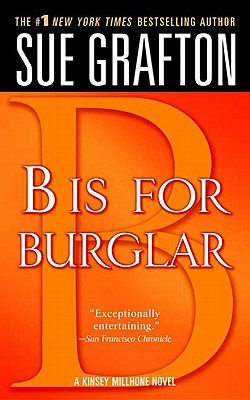 B is for Burglar
B is for Burglar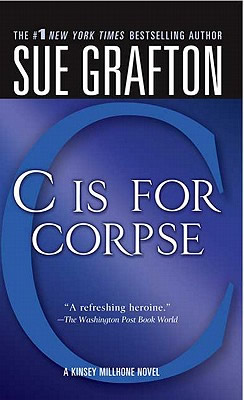 C is for Corpse
C is for Corpse D is for Deadbeat
D is for Deadbeat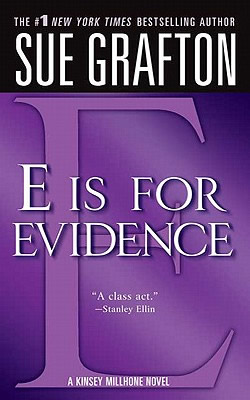 E is for Evidence
E is for Evidence F is for Fugitive
F is for Fugitive G is for Gumshoe
G is for Gumshoe H is for Homicide
H is for Homicide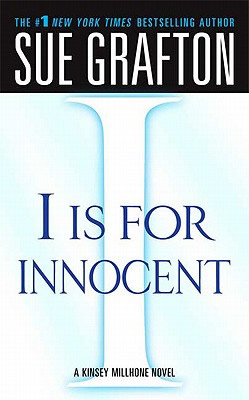 I is for Innocent
I is for Innocent J is for Judgment
J is for Judgment K is for Killer
K is for Killer L is for Lawless
L is for Lawless M is for Malice
M is for Malice N is for Noose
N is for Noose O is for Outlaw
O is for Outlaw P is for Peril
P is for Peril Q is for Quarry
Q is for Quarry R is for Ricochet
R is for Ricochet S is for Silence
S is for Silence T is for Trespass
T is for Trespass U is for Undertow
U is for Undertow V is for Vengeance
V is for Vengeance W is for Wasted
W is for Wasted X
X Y is for Yesterday
Y is for Yesterday